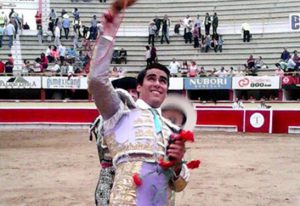Round One Goes to Frausto: First “Corrida de Oportunidad”, Tijuana, 2015

The great British theatre critic John Marks, writing in To the Bullfight observed that, “On paper, So-and-So, Thingummy, and young Whoozit should do well against the bulls bred by Count Whatisname, but the odds would defeat any odds maker, and the result is unpredictable.”
Thus there are no “bull bookies” or trifectas, odds on the “first cornada”, “first ear cut” or other such classic wagering chances in toreo—even in this age of great standardization—there are too many variables, too much on the line, to be able to offer anything approximating a fair bet…
Which does not alter the rather sudden appearance of wagers and predictions, comparisons and “lineages” and whatever scrap of evidence or intuition that might be brought to bear on determining the outcome—or more likely the wisdom of attending—the first of the three planned “Corridas de Oportunidad” presented this summer in Tijuana by Casa Toreros.
Something about the 6 matador/one bull apiece format invites a betting fervor that other corridas don’t, and this corrida provided surprises that would have pleased Sr. Marks’ contention of blind fate.
The Nuevo Leon ranch of “El Vergel” sent a sextet of generally impressive bulls, led by the marvelous “Testarudo” run in sixth place, a beautiful and seriously armed gray that offered nobility, frankness, and long duration his many attacks. The bulls run in first, fourth and fifth place also were good, though they lacked “Testarudo’s” nearly tireless determination to catch the lures offered him, and “Luisillo”, the cute little black faced by Godoy in the 4th spot seemed more than a little immature compared to his more serious brothers.
With “Gallito” a very “deep” and serious bull that appeared to have been dipped into every “bull color” paint can imaginable and left to drip dry, home-boy Castaneda was, actually, surprisingly good, especially with the big capote de brega, with which he showed himself to be both serious and creative. He followed with 3 estimable pairs of banderillas—during the first of which he stumbled, fell, and was at “Gallito’s” mercy for a brief instant, but offering all the advantages to his collaborator, who pardoned him at least twice. The faena de muleta offered some interesting moments, but they were too isolated to amount to anything more than appreciative applause following a full sword on the second attempt in the famous “Rincon de Ordonez”, which brought a quick end to a magnificent animal
Victor Mora had to deal with one of the two difficult animals of the day, “Tempano” by name, who offered precious little in the way of a consistent, clean attack. Mora—a capable if modest torero—managed a few isolated muletazos of great quality, but the whole “pulling teeth” aspect—and the seven pinchazos—sent Mora packing, dreaming, again, of another opportunity.
Ernesto Javier, “Calita”, was one of this reporter’s early favorites for inclusion in the cartel de triunfadores scheduled for August 30. Unfortunately, his evident determination to triumph (he met the bull with his cape as it left the corrals—porta gayola) was met by the increasingly craftiness of the handsome “Templadito”, who quickly oriented himself to the hide and seek game and caught and pummeled Javier once, and nearly repeated the beat down on two other occasions. Credit to “Calita” for persevering at no small risk, even after it became obvious that “Templadito” was never going to be “that bull.”
Jaliciense Oliver Godoy has built his still young but promising career around a style of delicate manners when his bulls would admit such things, but hard-nosed technical moves when called for. With the almost Facebook cuteness of “Luisillo” as his partner, Godoy turned in a pleasant but emotionally vapid performance, due completely to the lack of seriousness—age, armament, transmission—of the animal in front of him. A Facebook ear was cut—but Godoy is better than this little bull would allow for.
Perhaps the greatest incognito of the card was the young Alejandro Lopez, of Aguascalientes. Following his very competent, but not very compelling work with another of the afternoon’s great bulls, the very nicely cut “Ganador”, it was easy to see why. He seems technically competent enough—he was never in danger—but you got the feeling (if you got any feeling at all) watching him that absolutely NOTHING important was happening—anathema in the bullring; in a corrida of opportunity, with a bull like “Ganador”—the writing is—almost literally—on the wall; the way forward seems complicated…
Ricardo Frausto—having cut the only ear in the 2014 opener while appearing alongside “El Payo” and “Zotoluco,” , Ricardo was another of the “elenco” predicted by many in the aficion to do well. And, with the grand “Testarudo” a noble, long and straight charging animal that never seemed to tire or deviate from his clear path, he did—pretty well. Although the faena didn’t reach the depth or profundity that “Testarudo” stored inside Frausto was solid enough in the delivery of an excellent opening series of doubling passes to establish control, several tandas of terse derechazos, trademark Poncinas, appropriate adornments and a final full—if slightly off center—sword that had almost instantaneous effects. Two reasonable ears were cut, giving the first round to the talented young Hidrocalido.





